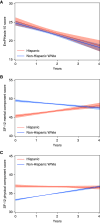Hispanic Ethnicity and Social Determinants of Health in Pulmonary Arterial Hypertension: The Pulmonary Hypertension Association Registry
- PMID: 35239467
- PMCID: PMC12039925
- DOI: 10.1513/AnnalsATS.202109-1051OC
Hispanic Ethnicity and Social Determinants of Health in Pulmonary Arterial Hypertension: The Pulmonary Hypertension Association Registry
Abstract
Rationale: There is a noticeable underrepresentation of minorities in clinical trials and registries in pulmonary arterial hypertension (PAH). Prior studies evaluating the association between Hispanic ethnicity and clinical outcomes in patients with PAH have not assessed the socioeconomic profile of Hispanic individuals or the significance of social determinants of health in clinical outcomes. Objectives: To determine the association between Hispanic ethnicity, social determinants of health, and clinical outcomes in PAH. Methods: This was a prospective cohort study of adult participants with PAH enrolled in the Pulmonary Hypertension Association Registry, a multicenter U.S.-based registry of patients treated at pulmonary hypertension care centers. Participants were classified as Hispanics and non-Hispanic White individuals, based on self-reported ethnicity. A comparison of baseline clinical and sociodemographic characteristics between groups was performed as well using absolute standardized differences (ASD). The primary outcome of the study was to assess transplant-free survival between Hispanics and non-Hispanic White individuals. A Cox proportional hazards model was used for the multivariable analysis after adjusting for age, sex, PAH etiology, annual income, education level, and health insurance. Results: A total of 683 individuals were included, 98 (14.3%) of Hispanic ethnicity. Hispanic patients had impaired access to health care (31.6% vs. 12.9% Medicaid/uninsured; ASD, 0.35), lower education level (72.6% vs. 94.0% high school graduates or higher; ASD, 0.60), and lower annual income (32.0% vs. 17.4% with income <20,000 U.S. dollars; ASD, 0.47), compared with non-Hispanic White individuals. Hispanic patients had a higher frequency of emergency room visits and a higher number of hospitalizations, despite having similar disease severity (incidence rate ratio, 1.452; 95% confidence interval [CI], 1.326-1.590; and 1.428; 95% CI, 1.292-1.577, respectively). Although the unadjusted analysis showed a lower transplant/death hazard ratio for Hispanics (hazard ratio, 0.47; 95% CI, 0.24-0.94; P = 0.032), there was no association between Hispanic ethnicity and outcome in the multivariable model after adjusting for social determinants of health and other covariates (HR, 0.76; 95% CI, 0.35-1.62; P = 0.474). Conclusions: Hispanic ethnicity was not associated with differences in survival after adjusting for social determinants of health and other factors. Social determinants of health are important to consider when assessing the association between ethnicity and outcomes in PAH.
Keywords: Hispanics; PHAR; ethnicity; pulmonary arterial hypertension; social determinants of health.
Figures



References
-
- Hoeper MM, Humbert M, Souza R, Idrees M, Kawut SM, Sliwa-Hahnle K, et al. A global view of pulmonary hypertension. Lancet Respir Med . 2016;4:306–322. - PubMed
-
- Benza RL, Miller DP, Gomberg-Maitland M, Frantz RP, Foreman AJ, Coffey CS, et al. Predicting survival in pulmonary arterial hypertension: insights from the Registry to Evaluate Early and Long-Term Pulmonary Arterial Hypertension Disease Management (REVEAL) Circulation . 2010;122:164–172. - PubMed
-
- Sitbon O, Benza RL, Badesch DB, Barst RJ, Elliott CG, Gressin V, et al. Validation of two predictive models for survival in pulmonary arterial hypertension. Eur Respir J . 2015;46:152–164. - PubMed
-
- Galiè N, Humbert M, Vachiery JL, Gibbs S, Lang I, Torbicki A, et al. 2015 ESC/ERS Guidelines for the diagnosis and treatment of pulmonary hypertension: the Joint Task Force for the Diagnosis and Treatment of Pulmonary Hypertension of the European Society of Cardiology (ESC) and the European Respiratory Society (ERS). Endorsed by: Association for European Paediatric and Congenital Cardiology (AEPC), International Society for Heart and Lung Transplantation (ISHLT) Eur Respir J . 2015;46:903–975. - PubMed
Publication types
MeSH terms
Grants and funding
LinkOut - more resources
Full Text Sources
Medical

